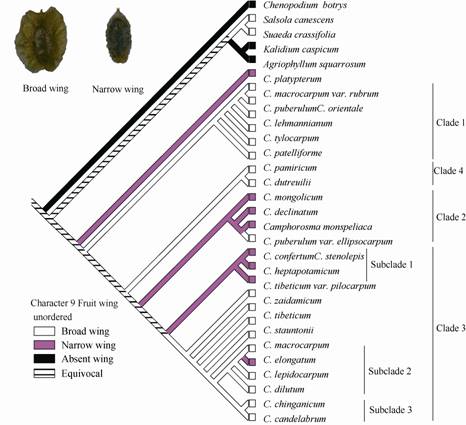Monophyly and Infrageneric Variation of Corispermum L. (Chenopodiaceae), Evidence from Sequence Data psbB-psbH, rbcL and ITS
2011-11-16
Chenopodiaceae, comprising 110 genera and 1,700 species worldwide, is one of the oldest and largest native and primarily desert families in Central Asian plants. Chenopodiaceae was initially divided into two subfamilies, Spirolobeae and Cyclolobeae. Corispermum, together with Anthochlamys and Agriophyllum, form the tribe Corispermeae, which belong to the subfamily Cyclolobeae. In Corispermum, certain characters used for segregation of a particular species and infraspecific entities were found to be unreliable and variable, e.g., plant size, branching habit, color, and shape of inflorescence, etc. Therefore, the currently accepted number of species in Corispermum is likely problematic; for instance, species numbers in China are probably exaggerated.
Owing to the morphological plasticity, the anatomical uniformity and the paucity of the molecular studies which focus on Corispermum, a more detailed study of molecular phylogeny is necessary. Therefore, XUE Juanjuan and professor ZHANG Mingli, attempted to conduct a molecular phylogeny of Corispermum and its relatives, using nrDNA ITS sequences, cpDNA psbB-psbH spacer sequences, and the rbcL gene of 22 species, with attention to: (1) test the monophyly of Corispermum and tribe Corispermeae; (2) research the phylogenetic relationship of the tribe Corispermeae; and (3) analyze the foundation of sectional classification within Corispermum from a phylogenetic aspect.
Their phylogenetic trees confirm that the tribe Corispermeae is monophyletic, Corispermum and Agriophyllum have a close relationship. Corispermum is demonstrated to be monophyletic, and contains at least four clades which, consequently, are served as the foundation of the infrageneric sectional variation of Corispermum, in terms of a combination of molecular data and morphological characters. The evolution of morphological characters for fruit wing and apex, two important characters in generic classification, is consistent with the sectional division of Corispermum, especially to the East Asian and Chinese taxa. The result has important significance to To understand the phylogeny and infrageneric variation of Corispermum.
This research was supported by the National Basic Research Program of China (2009CB825104), the CAS Important Direction for Knowledge Innovation Project (KZCX2-EW-305), and Xinjiang Institute of Ecology and Geography, Chinese Academy of Sciences.
This work has been published on Journal of Arid Land, 2011, 3(4):240-253. It can be linked from: http://jal.xjegi.com/EN/abstract/abstract98.shtml.

The character evolution cladogram of the fruit wing and the character distribution of having broad or narrow wings



